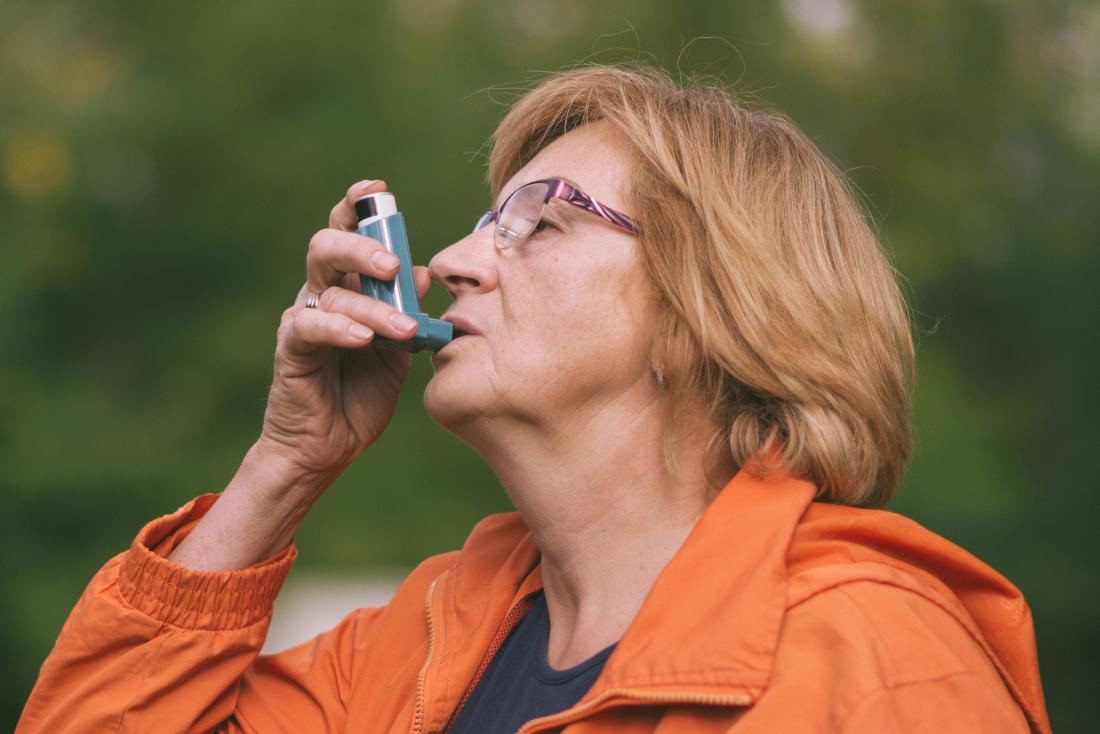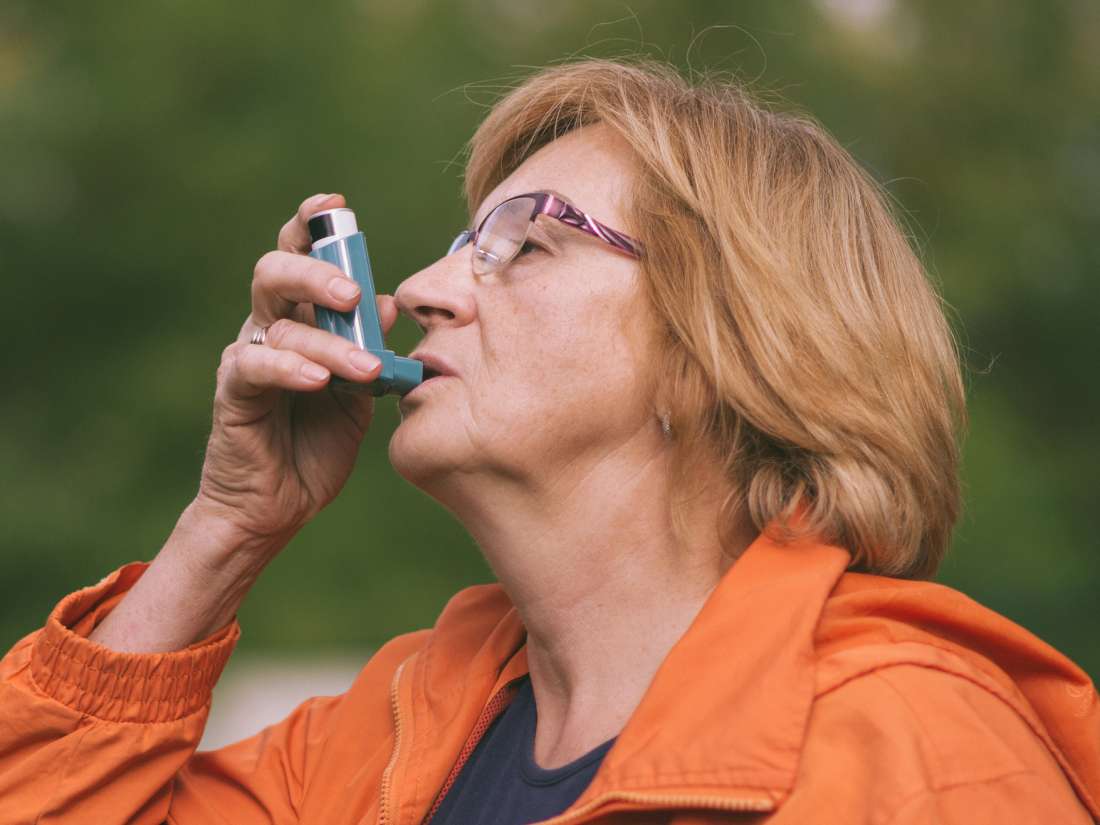Breathing treatments use medication to fight infections, remove mucus, dilate parts of the respiratory system, and improve breathing.
Breathing disorders, such as asthma, affect at least 25 million people in the United States — a figure that continues to grow.
Doctors prescribe breathing treatments for respiratory problems. While anyone can have respiratory issues due to an illness or infection, people with chronic respiratory diseases are more vulnerable.
In many cases, a person must take this medication with a nebulizer or an inhaler. These devices allow a person to inhale the drug directly into the airways, rapidly improving breathing.
Read on to learn about the types of breathing treatment that can help treat symptoms of respiratory illness.
Bronchodilators

A person may use a bronchodilator to help treat asthma and COPD.
Bronchodilators help relax the muscles in the lower airways, opening the bronchi and bronchioles, which are small passageways in the lungs that help a person breathe.
Dilating these passageways makes it easier for oxygen to flow to the lungs.
Bronchodilators can treat asthma and chronic obstructive pulmonary disease (COPD).
Doctors may also prescribe them for some other conditions, including breathing difficulties relating to lung cancer or exercise-induced constriction.
Many different bronchodilators are available. Most bronchodilators are beta2-agonists, which means that they stimulate the body’s beta cells to relax the airways.
The most common bronchodilators include:
- Short-acting beta agonists (SABA): These drugs offer rapid relief of serious symptoms, such as those that occur during an asthma attack. A person usually uses an inhaler to take these drugs. They may include the medications albuterol and levalbuterol.
- Long-acting beta agonists (LABA): A person takes these drugs every day to keep their bronchial tubes relaxed. They include medications such as formoterol and salmeterol. People with asthma who take LABAs must also take corticosteroids.
Corticosteroids
Corticosteroids mimic the body’s natural hormones to reduce inflammation from allergies and conditions such as asthma.
Although some doctors also prescribe corticosteroids for COPD, the evidence supporting their use for this condition is mixed. Research from 2012 suggests that they are ineffective as the sole treatment for COPD.
However, the authors of a 2014 article noted that while several placebo-controlled trials have shown that corticosteroids can treat moderate to severe COPD, there is a lack of evidence to suggest that they are effective in treating stable COPD.
Corticosteroids come in oral, inhaled, and intravenous (IV) formulations. Specific corticosteroids that doctors may prescribe as a breathing treatment include:
- budesonide
- mometasone
- fluticasone
Doctors often combine corticosteroids with long-acting beta2-agonists. This treatment approach is called combination therapy.
Antimicrobial drugs

Doctors may prescribe antimicrobial drugs to fight pathogens that infect the airways.
Antimicrobial drugs, which include antibiotics and antifungal medications, fight pathogens that infect the airways.
Anyone can have a respiratory infection — such as the common cold — that makes breathing difficult, but people with chronic respiratory infections are more likely to experience serious side effects.
For example, people with HIV are vulnerable to a type of fungal pneumonia called Pneumocystis pneumonia. To fight this infection and treat respiratory symptoms, doctors may prescribe a drug called pentamidine, which can kill the fungus.
Doctors usually prescribe oral antimicrobial drugs, though serious infections might require IV treatment. People with serious respiratory disorders may also need to take inhaled antibiotics.
Mucolytics
Mucolytics are drugs that help loosen sputum, the mucus that the respiratory tract produces. Too much mucus can clog the airway, causing excessive coughing, inflammation, and difficulty breathing.
Allergic reactions and some chronic breathing disorders, such as chronic bronchitis or COPD, may trigger the body to produce too much mucus.
A 2019 Cochrane review that analyzed 38 studies found that mucolytics reduced the risk of flare-ups in people with chronic bronchitis and COPD. Mucolytics also reduced the number of days during which a person was unable to do their everyday tasks, but only by less than half a day per month.
Epinephrine
People with severe allergies can experience a life-threatening reaction called anaphylaxis. Anaphylaxis quickly narrows or closes the airways, making breathing difficult. Without prompt treatment, it can be fatal.
In most people, an epinephrine injection quickly reverses an allergic reaction, allowing them to breathe again.
People with a history of severe allergic reactions or with allergies that commonly cause anaphylaxis may need to carry an epinephrine autoinjector (EpiPen) with them at all times. This portable device allows a person to quickly inject themselves or have someone else inject them with epinephrine.
Leukotriene inhibitors
Leukotrienes are inflammatory chemicals that the immune system releases in response to allergens and some other irritants. They constrict the airways and cause the body to release excess mucus, which can lead to congestion and difficulty breathing.
Leukotriene inhibitors, or leukotriene modifiers, can help prevent inflammation due to asthma and allergies. Types of leukotriene inhibitor include:
- montelukast
- zafirlukast
- zileuton
Immunotherapy
Immunotherapy is an emerging new way to treat respiratory problems. One immunotherapy treatment uses monoclonal antibodies to bind to inflammatory chemicals that make breathing more difficult. Monoclonal antibodies can treat many different conditions, including some cancers.
Some monoclonal antibody treatments may help treat specific types of severe asthma when traditional treatments fail.
When to see a doctor

A person should consult a doctor if they are experiencing chronic trouble breathing.
Although many respiratory medications are available over the counter, breathing treatments are prescription drugs. People who think that they might need a breathing treatment should see a doctor.
Signs that a person might need a breathing treatment include:
- having a respiratory or breathing disorder that is getting worse or not responding to medication
- having chronic trouble breathing
- experiencing frequent allergic reactions
- having frequent congestion or coughing
- experiencing shortness of breath, dizziness, or trouble breathing when exercising
Some respiratory problems require immediate treatment. Go to the emergency room or call 911 for:
- severe breathing problems that make breathing feel impossible
- loss of consciousness due to breathing issues
- signs of anaphylaxis
- a severe asthma attack that does not respond to inhalers or other treatments
- severe dizziness or lightheadedness due to a chronic respiratory condition
- signs of respiratory distress, such as wheezing, blue skin, or nostril flaring, in a newborn or infant
Summary
Both chronic and acute breathing issues can be frightening and cause distress. Prompt breathing treatments can relieve discomfort and help a person breathe again.
People with chronic respiratory conditions, such as asthma and COPD, should schedule regular appointments to discuss their treatment and symptoms with a doctor.
A respiratory specialist can help a person devise a treatment plan for both chronic and acute symptoms, which can help make breathing difficulties feel more manageable.
